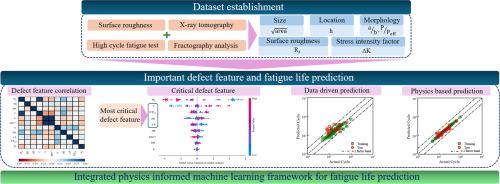An improved fatigue life prediction via defect-informed intelligent learning method
IF 9.4
1区 工程技术
Q1 ENGINEERING, MECHANICAL
International Journal of Mechanical Sciences
Pub Date : 2025-09-24
DOI:10.1016/j.ijmecsci.2025.110885
引用次数: 0
Abstract
Porosities evolving during the additive manufacturing process dominantly control the fatigue life of the fabricated component and make its prediction challenging. Generally, fracture mechanics and defect-based models are used to predict their fatigue lives, but often fail to capture the defects’ characteristics. This study introduces a new defect-based parameter derived from integrating the critical defect morphologies to improve the fatigue life prediction capability by incorporating it into machine learning algorithms. This approach effectively captures the complex relationship between the defect’s characteristics and fatigue life. The input features, such as defect size, its shape, its location, and surface roughness, were utilized to train the three popular machine learning models, namely, deep neural network, support vector machine, and random forest. The SHapley Additive exPlanations analysis indicates that defect morphology and surface roughness are among the most influential features affecting fatigue life. The results reveal that the integration of the proposed parameter into the machine learning framework enhances the prediction accuracy with an R2 score of 0.84 compared to the conventional defect-based machine learning approaches with an R2 score of 0.34 and the existing physics-based model with an R2 score of 0.32. The proposed model predicted fatigue life that majorly falls within twice the error band. The new framework demonstrates enhanced capability in capturing the scale effect on the fatigue lives compared to the existing physics-informed machine learning models, highlighting its effectiveness and robustness. The proposed model effectively captured the complex relationship between the defect's characteristics and fatigue life. This work contributed toward unlocking a new pathway in the predictive capability of a combined machine learning and defect-based model.

基于缺陷信息的智能学习方法改进疲劳寿命预测
增材制造过程中孔隙率的变化主要控制着制造部件的疲劳寿命,并使其预测具有挑战性。通常,断裂力学和基于缺陷的模型用于预测其疲劳寿命,但往往不能捕捉到缺陷的特征。本研究引入了一种新的基于缺陷的参数,该参数通过将关键缺陷形态整合到机器学习算法中来提高疲劳寿命预测能力。该方法有效地捕捉了缺陷特征与疲劳寿命之间的复杂关系。利用缺陷大小、形状、位置和表面粗糙度等输入特征,训练三种常用的机器学习模型,即深度神经网络、支持向量机和随机森林。SHapley加性解释分析表明,缺陷形貌和表面粗糙度是影响疲劳寿命的主要因素。结果表明,与传统的基于缺陷的机器学习方法的R2分数为0.34和现有的基于物理的模型的R2分数为0.32相比,将所提出的参数集成到机器学习框架中可以提高预测精度,R2分数为0.84。该模型预测的疲劳寿命主要落在误差带的两倍以内。与现有的基于物理的机器学习模型相比,新框架在捕获疲劳寿命的尺度效应方面表现出了更强的能力,突出了其有效性和鲁棒性。该模型有效地捕捉了缺陷特征与疲劳寿命之间的复杂关系。这项工作为机器学习和基于缺陷的模型的预测能力开辟了一条新的途径。
本文章由计算机程序翻译,如有差异,请以英文原文为准。
求助全文
约1分钟内获得全文
求助全文
来源期刊

International Journal of Mechanical Sciences
工程技术-工程:机械
CiteScore
12.80
自引率
17.80%
发文量
769
审稿时长
19 days
期刊介绍:
The International Journal of Mechanical Sciences (IJMS) serves as a global platform for the publication and dissemination of original research that contributes to a deeper scientific understanding of the fundamental disciplines within mechanical, civil, and material engineering.
The primary focus of IJMS is to showcase innovative and ground-breaking work that utilizes analytical and computational modeling techniques, such as Finite Element Method (FEM), Boundary Element Method (BEM), and mesh-free methods, among others. These modeling methods are applied to diverse fields including rigid-body mechanics (e.g., dynamics, vibration, stability), structural mechanics, metal forming, advanced materials (e.g., metals, composites, cellular, smart) behavior and applications, impact mechanics, strain localization, and other nonlinear effects (e.g., large deflections, plasticity, fracture).
Additionally, IJMS covers the realms of fluid mechanics (both external and internal flows), tribology, thermodynamics, and materials processing. These subjects collectively form the core of the journal's content.
In summary, IJMS provides a prestigious platform for researchers to present their original contributions, shedding light on analytical and computational modeling methods in various areas of mechanical engineering, as well as exploring the behavior and application of advanced materials, fluid mechanics, thermodynamics, and materials processing.
 求助内容:
求助内容: 应助结果提醒方式:
应助结果提醒方式:


